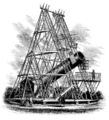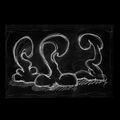Template:Selected anniversaries/August 28: Difference between revisions
No edit summary |
No edit summary |
||
| Line 4: | Line 4: | ||
||1749: Johann Wolfgang von Goethe born ... writer and statesman. His works include four novels; epic and lyric poetry; prose and verse dramas; memoirs; an autobiography; literary and aesthetic criticism; and treatises on botany, anatomy, and color. In addition, there are numerous literary and scientific fragments, more than 10,000 letters, and nearly 3,000 drawings by him extant. Pic. | ||1749: Johann Wolfgang von Goethe born ... writer and statesman. His works include four novels; epic and lyric poetry; prose and verse dramas; memoirs; an autobiography; literary and aesthetic criticism; and treatises on botany, anatomy, and color. In addition, there are numerous literary and scientific fragments, more than 10,000 letters, and nearly 3,000 drawings by him extant. Pic. | ||
||1789: With the first use of his new 1.2 m (3.9 ft) telescope, then the largest in the world, William Herschel discovered a new moon of Saturn, which was later named Enceladus | File:William_Herschel's_40-foot_(12_m)_reflecting_telescope.jpg|link=William Herschel (nonfiction)|1789: With the first use of his new 1.2 m (3.9 ft) telescope, then the largest in the world, [[William Herschel (nonfiction)|William Herschel]] discovered a new moon of Saturn, which was later named Enceladus. | ||
||1796: Irénée-Jules Bienaymé born ... statistician. He built on the legacy of Laplace generalizing his least squares method. He contributed to the fields of probability and statistics, and to their application to finance, demography and social sciences. In particular, he formulated the Bienaymé–Chebyshev inequality concerning the law of large numbers and the Bienaymé formula for the variance of a sum of uncorrelated random variables. Pic. | ||1796: Irénée-Jules Bienaymé born ... statistician. He built on the legacy of Laplace generalizing his least squares method. He contributed to the fields of probability and statistics, and to their application to finance, demography and social sciences. In particular, he formulated the Bienaymé–Chebyshev inequality concerning the law of large numbers and the Bienaymé formula for the variance of a sum of uncorrelated random variables. Pic. | ||
| Line 65: | Line 65: | ||
||1965: Giulio Racah dies ... physicist and mathematician. Pic. | ||1965: Giulio Racah dies ... physicist and mathematician. Pic. | ||
||1993: Edward Palmer Thompson dies ... historian, writer, socialist and peace campaigner. Pic (megaphone). | ||1993: Edward Palmer Thompson dies ... historian, writer, socialist and peace campaigner. Pic (megaphone). | ||
Revision as of 09:29, 28 August 2020
413 BC: A lunar eclipse caused panic among the sailors of the Athens fleet and thus affected the outcome of a crucial battle in the Peloponnesian War. The Athenians were ready to withdraw their forces from Syracuse when the Moon was eclipsed, but the eclipse caused the superstitious Athenian general Nicias to delay their departure. This delay gave an advantage to their enemies, the Syracusans, who then defeated the entire Athenian fleet and army, and killed Nicias.
1789: With the first use of his new 1.2 m (3.9 ft) telescope, then the largest in the world, William Herschel discovered a new moon of Saturn, which was later named Enceladus.
1801: Mathematician and philosopher Antoine Augustin Cournot born. He will introduce the ideas of functions and probability into economic analysis.
1916: Sociologist and author C. Wright Mills born. He will be published widely in popular and intellectual journals, advocating public and political engagement over disinterested observation.
2019: Signed first edition of Three Kings sells for an undisclosed amount to "a couple, both eminent Gnomon algorithm theorists and long-time residents of New Minneapolis, Canada."




